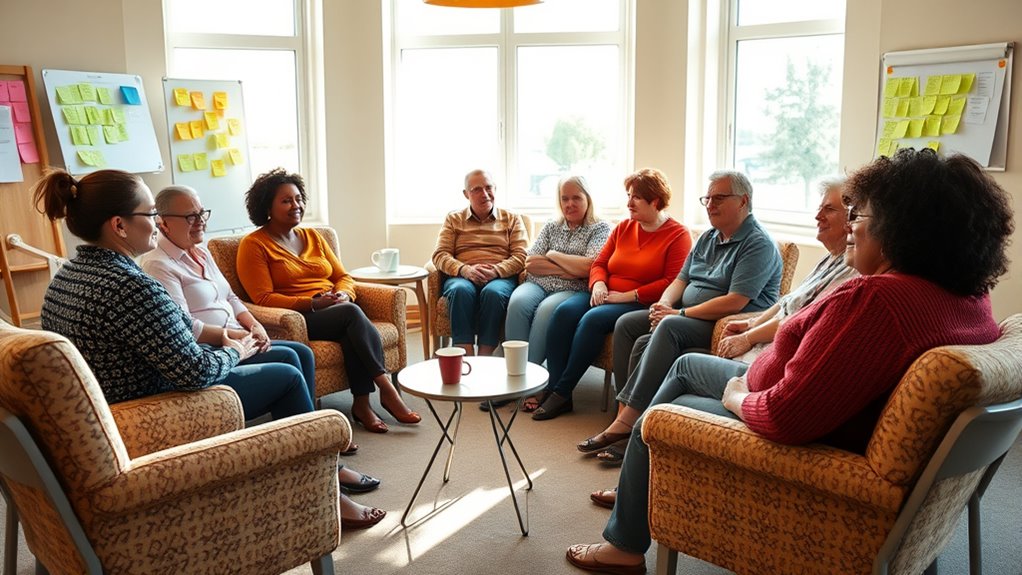To build a caregiver support group in your city, start by evaluating local caregiver needs through surveys and conversations. Connect with community centers, healthcare providers, and organizations to find potential members and partners. Choose an accessible venue, considering transportation and accommodations for all. Plan engaging activities and gather ongoing feedback to adapt. Focus on fostering strong relationships and leadership within the group. Keep exploring these strategies, and you’ll discover more ways to create a thriving support space.
Key Takeaways
- Assess community needs through surveys and conversations to tailor support topics and foster emotional resilience.
- Partner with local organizations, healthcare providers, and community centers to expand outreach and resources.
- Choose accessible venues near public transit with accommodations for mobility, hearing, and visual impairments.
- Incorporate diverse formats like virtual workshops, peer mentorship, and interactive activities to engage members.
- Continuously gather feedback, adapt offerings, and develop leadership opportunities to sustain growth and relevance.
Assessing the Needs of Local Caregivers
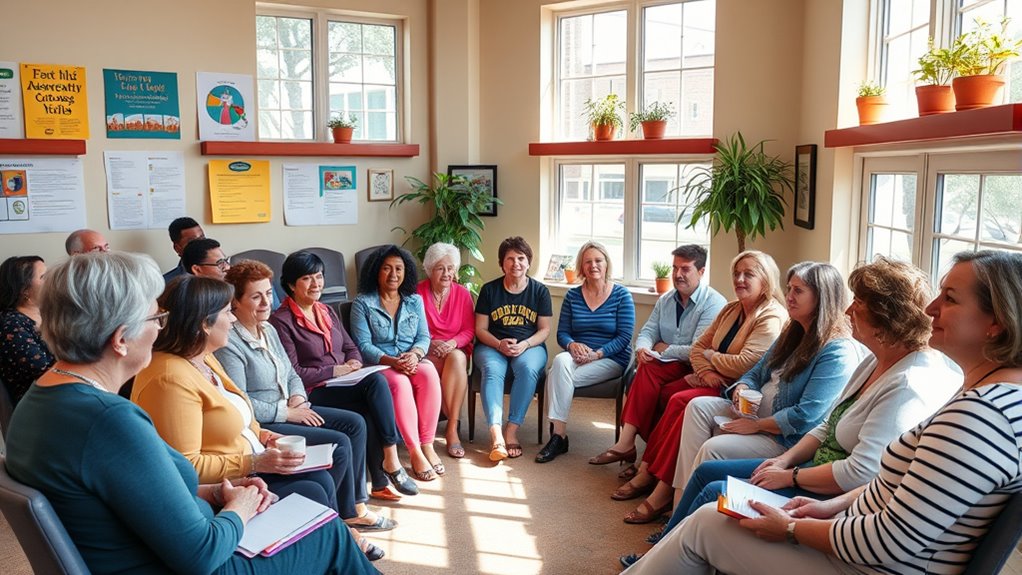
How can you guarantee your caregiver support group truly meets the community’s needs? Start by evaluating what caregivers struggle with most. Many face caregiver burnout, feeling overwhelmed and exhausted, which diminishes their emotional resilience. Understanding these challenges helps you tailor your group’s focus. Conduct surveys or informal conversations to gather insights about their daily struggles, emotional support needs, and preferred meeting formats. Pay attention to patterns indicating high stress levels or common sources of frustration. This assessment ensures you address real issues, fostering a supportive environment that boosts emotional resilience. Additionally, being aware of factors like state-specific tax laws can help you plan resources or benefits that support caregivers financially. By actively listening to caregivers’ experiences, you lay a solid foundation for a group that genuinely supports their mental health and resilience, making your efforts both meaningful and effective.
Identifying and Connecting With Potential Members
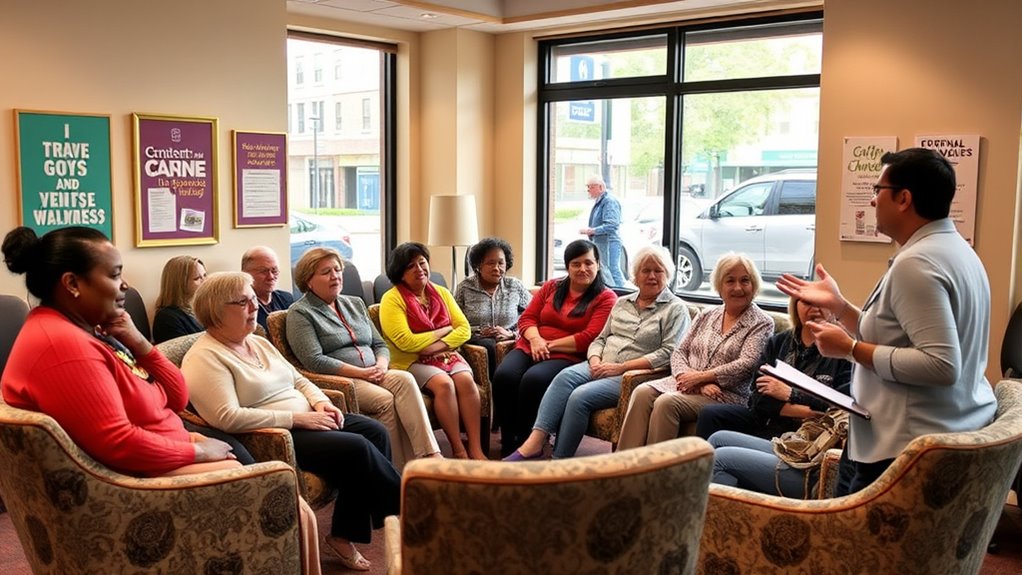
To build a successful caregiver support group, you need to identify and connect with potential members who will benefit most from your efforts. Start by reaching out through peer networking platforms, local community centers, and healthcare providers. Attend events where caregivers gather and listen for those expressing emotional support needs. You can also create flyers or online posts that highlight the group’s purpose and invite caregivers to join. When connecting with potential members, focus on offering genuine empathy and understanding. Personal outreach can help build trust and encourage participation. Remember, emotional support is a core benefit of your group, so emphasize that your group provides a safe space for caregivers to share experiences and find comfort. Additionally, understanding relationship dynamics can help you better support caregivers facing complex emotional challenges. This approach helps you attract committed members who value peer connection.
Choosing a Convenient and Accessible Meeting Location
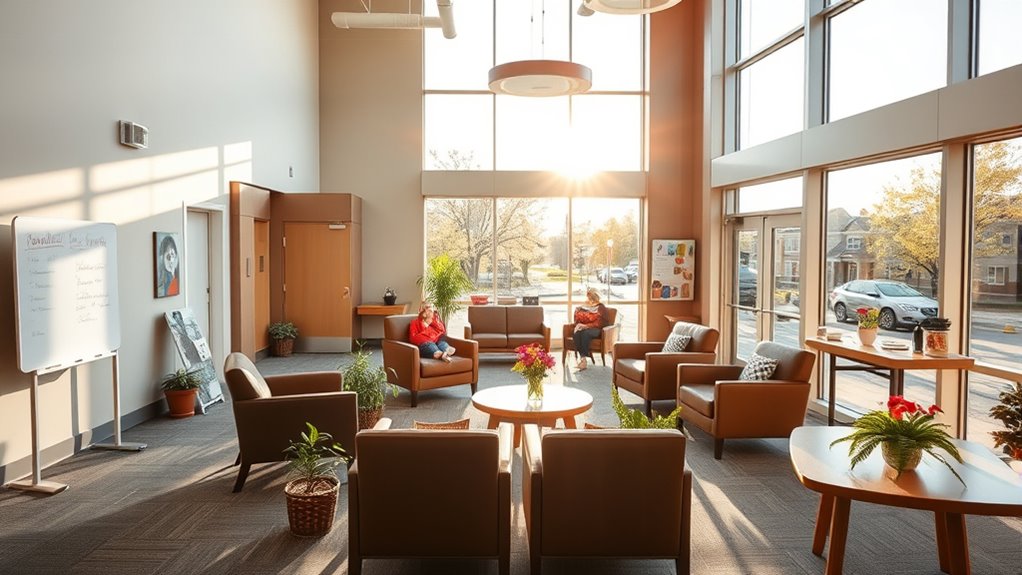
When selecting a meeting location, consider options near public transportation or central areas to make it easier for members to attend. Make certain the space has accessibility features like ramps or elevators to accommodate everyone’s needs. Also, check for convenient parking or transit options to reduce any extra hassle for your group. Additionally, reviewing the company values of potential venues can help ensure the environment aligns with your group’s supportive and inclusive culture.
Central Location Options
Choosing the right meeting location is essential for ensuring your caregiver support group is accessible and welcoming. When considering central location options, look for venues that are easy to reach by public transportation or are close to major roads. Good venue options include community centers, libraries, or local churches, which often have flexible seating arrangements. Opt for spaces with adaptable seating arrangements so you can set up in a way that encourages conversation and connection. It’s important that the venue isn’t just convenient but also comfortable and welcoming. Consider the size of the space to guarantee it can accommodate your group comfortably. Additionally, understanding AI in Education can help in selecting venues that leverage technology for better communication and engagement. By selecting a central, accessible venue with flexible seating, you’ll make it easier for caregivers to attend regularly and feel at ease.
Accessibility Features Needed
Ensuring your caregiver support group meets in a location with the right accessibility features is essential for encouraging attendance and inclusivity. Choose a venue that complies with accessibility guidelines, providing ramps, elevators, and wide doorways. Consider assistive technology like hearing loops or sign language interpreters to support diverse needs. When selecting a space, ask about features that accommodate mobility, visual, and hearing impairments. To help visualize, here’s a quick comparison:
| Feature | Importance |
|---|---|
| Ramps and elevators | Ensure easy access for all mobility levels |
| Hearing assistance devices | Support participants with hearing challenges |
| Clear signage | Help navigate space comfortably |
Additionally, verifying the hours of operation of potential venues ensures your group can meet conveniently.
Parking and Transit
Selecting a meeting location that offers convenient parking and accessible transit options can substantially boost attendance and inclusivity. Effective parking management guarantees attendees can find spots easily, reducing stress and time spent searching. Look for locations with ample parking, clear signage, and low-cost or free options. Additionally, prioritize transit options like bus stops, train stations, or bike racks nearby, making it easier for caregivers without cars to attend. Consider public transportation schedules and routes to ensure your meeting spot aligns with transit availability. A well-chosen location minimizes logistical barriers, encouraging consistent attendance and fostering a welcoming environment. Incorporating predictive modeling can help identify the most accessible locations based on attendance patterns and transportation data, making your support group more inclusive. By focusing on parking management and transit options, you make your support group more accessible, ensuring everyone has a fair chance to participate.
Setting Clear Goals and Objectives for Your Group

Establishing clear goals and objectives is essential for guiding your caregiver support group and measuring its success. When you define specific goals, you ensure that everyone understands the purpose and direction of the group, fostering goal alignment among members. Clear objectives help you track progress and determine whether the group is achieving its intended impact. Focus on setting measurable outcomes, such as increasing member engagement or providing educational resources, so you can evaluate success over time. By establishing these goals early on, you create a solid foundation for your group’s activities and growth. Remember, well-defined goals keep meetings focused, motivate members, and provide a benchmark to celebrate achievements along the way. Incorporating best practices from successful groups can further enhance your efforts and ensure sustainability.
Planning and Facilitating Engaging Meetings
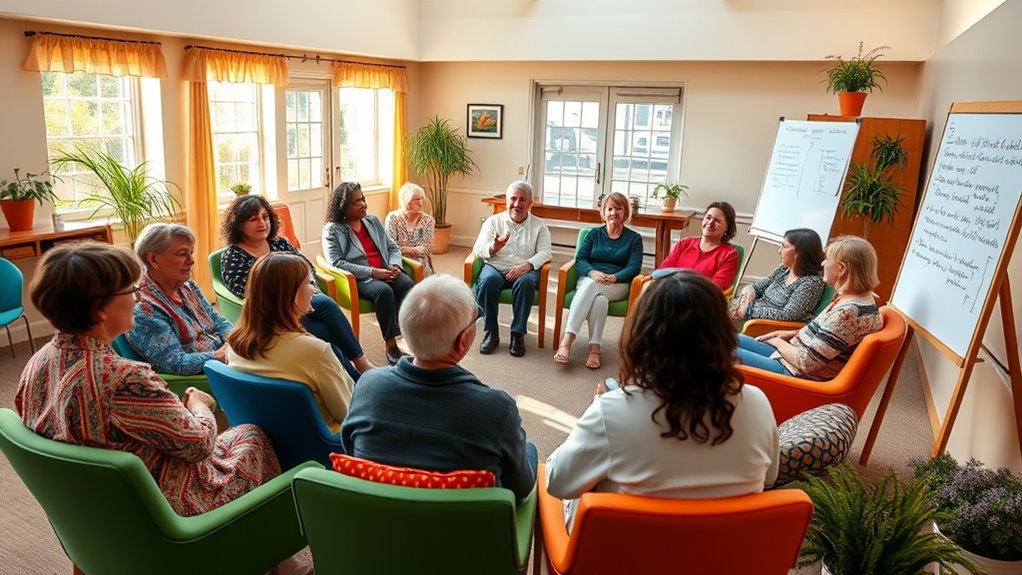
Having clear goals and objectives in place sets the stage for productive meetings, but to keep members engaged, you need to plan and facilitate sessions that are dynamic and meaningful. Start by creating varied formats, like incorporating mindfulness techniques to help caregivers relax and connect. Use interactive activities to foster participation and shared experiences. Additionally, involve volunteers to assist with logistics or lead small group discussions, which boosts engagement and eases your workload. Recognizing retail hours can also be helpful when scheduling meetings to avoid conflicts with shopping or other errands.
Promoting Your Support Group Through Various Channels

Wondering how to reach more caregivers who could benefit from your support group? Start by leveraging social media platforms like Facebook, Twitter, or Instagram to spread the word. Create engaging posts that highlight the group’s purpose and meeting details, making it easy for caregivers to find and join. Additionally, distribute printed flyers in community centers, clinics, libraries, and local businesses where caregivers frequently visit. Ensure your flyers are clear, visually appealing, and include contact information. Combining online and offline promotion helps you reach a broader audience and increases awareness about your support group. Consistent messaging across channels fosters familiarity and encourages caregivers to participate, ultimately building a stronger, more connected community. Contrast ratio plays a role in creating an inviting environment by ensuring good visibility in different lighting conditions, which can encourage more caregivers to feel comfortable attending your meetings.
Building Partnerships With Local Organizations and Resources
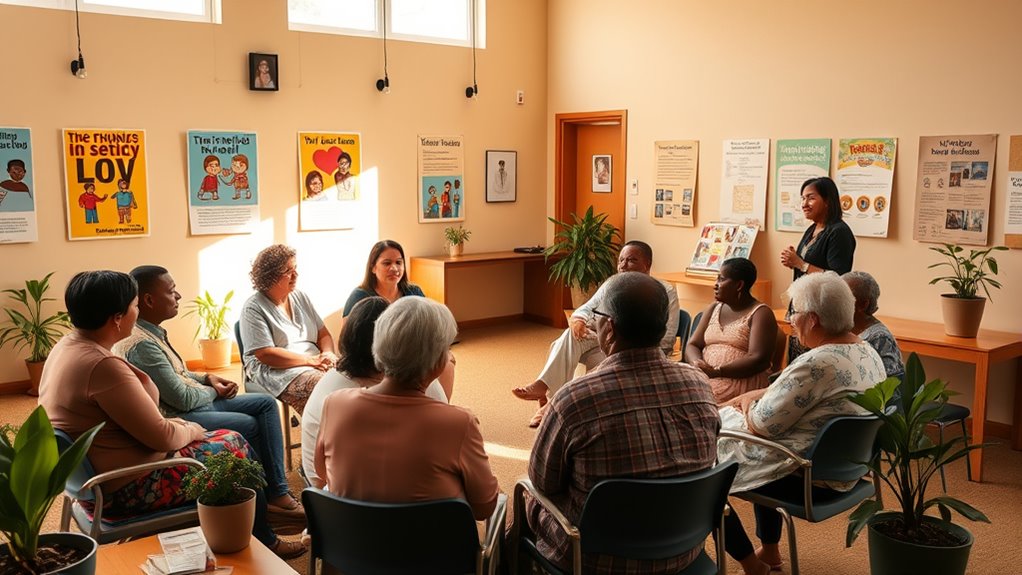
To strengthen your caregiver support group, start by identifying local organizations that share your mission. Reach out to these partners to explore ways you can collaborate and share resources. Leveraging community assets will help you build a more effective and sustainable support network. Incorporating community assets such as local health clinics and social services can further enhance your group’s impact.
Identifying Community Partners
Building strong partnerships with local organizations and resources is essential for creating an effective caregiver support group. To identify community partners, you should research organizations that serve caregivers or related populations. Reach out with clear outreach strategies that highlight mutual benefits. Focus on building relationships with:
- Local healthcare providers and clinics
- Senior centers and community centers
- Nonprofits involved in caregiving support
These partners can assist with volunteer recruitment and help expand your group’s reach. Attend community meetings and networking events to connect with potential allies. Establishing these partnerships early guarantees you have diverse resources and a broader support network for caregivers. Collaborating with trusted organizations also boosts credibility and encourages community involvement.
Leveraging Local Resources
Leveraging local resources is a pivotal step in strengthening your caregiver support group by forming meaningful partnerships with community organizations. These collaborations can provide access to mobile apps, online forums, and local events that boost support and information sharing. Partnering with local clinics or senior centers can offer meeting spaces, while organizations might promote your group through their newsletters. Online forums and mobile apps tailored for caregivers can connect members beyond meetings, offering continuous support. Consider creating resource tables at community events or hosting joint workshops to expand your reach. Use this table to identify potential partners:
| Organization Type | Resources Offered | Partnership Benefits |
|---|---|---|
| Senior Centers | Meeting space | Increased visibility |
| Local Clinics | Health resources | Access to healthcare info |
| Community Centers | Event hosting | Broader community reach |
| Online Forums | Virtual support | 24/7 accessibility |
Incorporating Different Support Formats and Activities
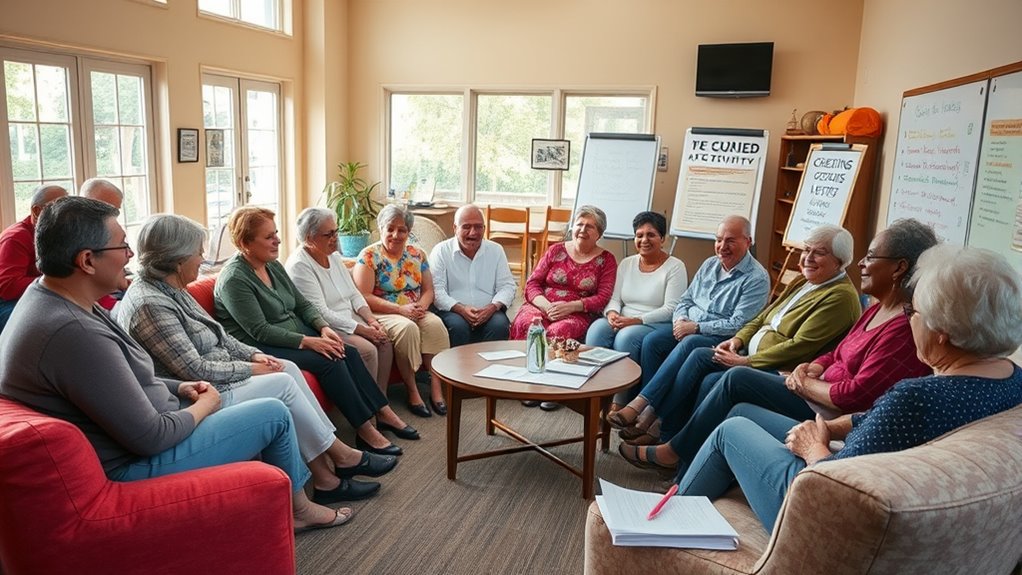
Incorporating a variety of support formats and activities can make your caregiver group more engaging and effective. Offering different options helps meet members’ diverse needs and keeps the group dynamic. You might include:
- Virtual workshops, which provide flexible learning on topics like stress management or healthcare navigation
- Peer mentorship programs, connecting experienced caregivers with newcomers for guidance and support
- Interactive activities, such as discussion circles or skill-sharing sessions, to foster connection and practical learning
Mixing formats ensures members stay involved and feel valued. Virtual workshops allow participation regardless of location, while peer mentorship builds strong, supportive relationships. Incorporate these activities thoughtfully to create a vibrant, inclusive environment that sustains caregiver engagement and growth.
Gathering Feedback and Adapting to Members’ Needs
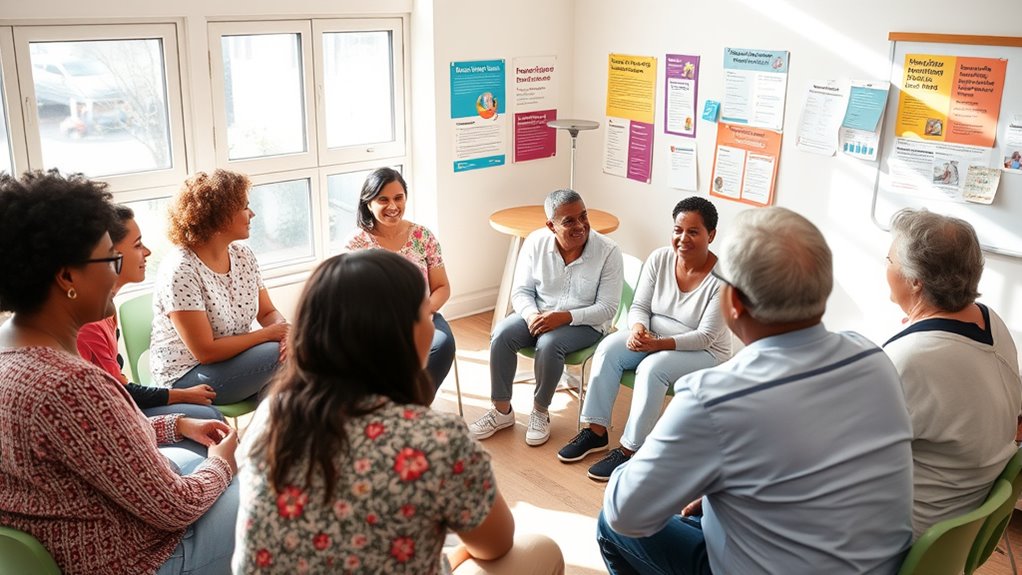
To guarantee your caregiver support group remains effective and relevant, actively gathering feedback from members is essential. Regular feedback collection helps you understand member preferences and identify areas for improvement. Encourage open communication by asking specific questions about meeting topics, formats, and the overall experience. Use surveys, suggestion boxes, or informal conversations to gather insights. Pay close attention to recurring themes or concerns, and be willing to adapt your approach accordingly. Showing members that their opinions matter fosters trust and engagement. By continuously listening and adjusting based on their feedback, you create a supportive environment that truly meets their needs. This proactive approach ensures your group remains responsive, valuable, and aligned with the evolving needs of caregivers.
Sustaining Growth and Encouraging Leadership Development
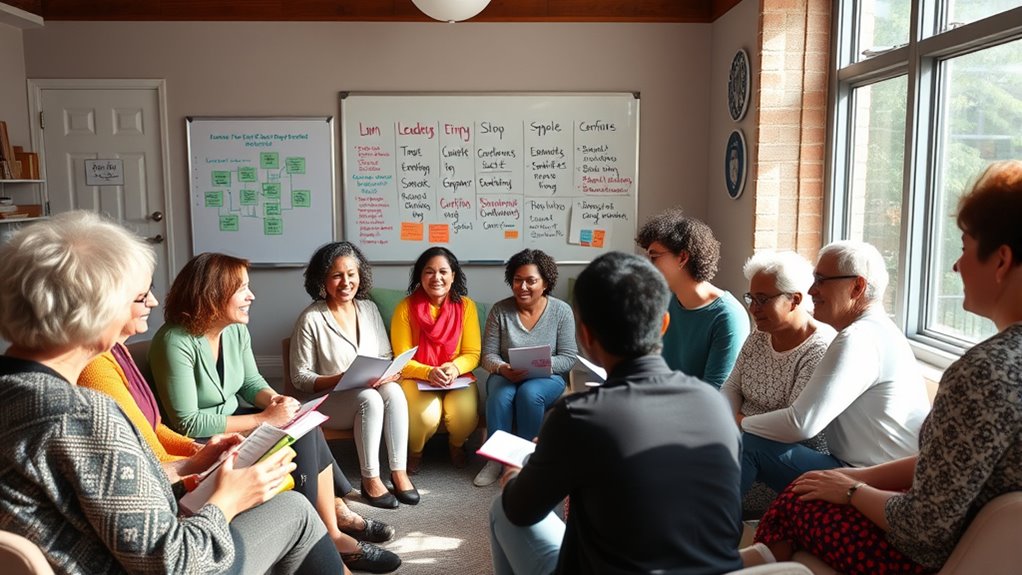
Sustaining the growth of your caregiver support group requires intentional effort to foster ongoing engagement and development. To encourage leadership development, prioritize leadership training that equips members with the skills to lead initiatives and mentor newcomers. Volunteer recruitment is essential—actively seek passionate members willing to take on responsibilities and grow into leadership roles.
Foster ongoing engagement by offering leadership training and recognizing volunteers to sustain your support group’s growth.
- Offer regular leadership workshops to build confidence and skills
- Recognize and celebrate volunteer contributions to motivate continued involvement
- Create clear pathways for members to assume leadership positions and responsibilities
Frequently Asked Questions
How Can I Ensure Diverse Caregiver Representation in the Group?
To guarantee diverse caregiver representation, focus on promoting cultural inclusion and addressing language barriers. Reach out through community organizations, faith groups, and social media to connect with varied backgrounds. Offer materials in multiple languages and create an inclusive environment where everyone feels valued. Encourage diverse participation by actively listening, respecting different perspectives, and tailoring activities to meet the unique needs of all caregivers, fostering a truly inclusive support group.
What Funding Options Are Available to Support the Group’S Activities?
Funding fosters flourishing activities for your group. You can explore grant opportunities that provide generous, grant-giving funds, supporting your initiatives. Sponsorship options from local businesses or organizations can also considerably strengthen your group’s sustainability. By actively seeking these financial sources, you guarantee your caregiver support group stays strong, sustainable, and able to serve caregivers effectively. Remember, proactive pursuit of funding options fuels your group’s ongoing growth and impact.
How Do I Handle Sensitive Topics During Meetings?
When handling sensitive topics during meetings, use empathy techniques to create a safe space, showing genuine understanding and compassion. Always follow confidentiality protocols by reminding participants that what’s shared stays private, encouraging openness without fear. Listen actively, avoid judgment, and validate feelings. If a topic becomes too personal or distressing, gently steer the conversation towards resources or support options, ensuring everyone feels respected and supported.
What Legal or Privacy Considerations Should I Be Aware Of?
When handling sensitive topics, you should prioritize legal and privacy considerations. You’ll want to establish confidentiality agreements to protect members’ privacy and guarantee trust. Additionally, obtaining informed consent before sharing personal stories or information helps members understand their rights and boundaries. By actively implementing these measures, you create a safe environment where members feel secure sharing their experiences without fear of breaches or misunderstandings.
How Can I Measure the Group’s Long-Term Impact Effectively?
You might feel like measuring your group’s impact is an impossible task, but it’s totally doable! Use clear feedback mechanisms like surveys and interviews to gather honest insights. Track success metrics such as improved caregiver well-being, increased engagement, and community involvement over time. Regularly analyze this data to see real progress, helping you adapt and grow your support group into a lasting, meaningful resource for caregivers.
Conclusion
Starting a caregiver support group might seem intimidating at first, but with dedication, you’ll create a crucial community. Imagine a space where members share stories, find comfort, and grow stronger together, even amid life’s chaos. If you’re worried about time or resources, remember that small steps—like a local coffee shop or online meetings—can make a big difference. Your efforts can transform loneliness into connection, empowering caregivers to face challenges with renewed hope.
